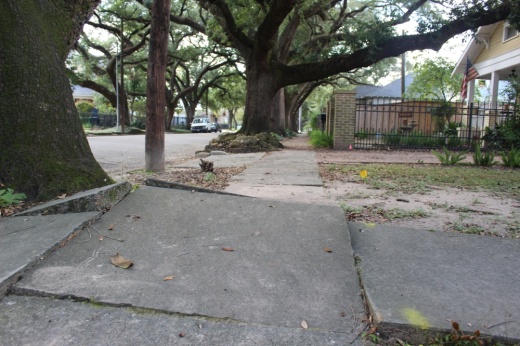At-large Council Members Sallie Alcorn and David Robinson collaborated on the inaugural Sidewalk Summit at the end of September, bringing together transportation advocates and city staff to discuss key policies city leaders want to implement to bring more sidewalks to neighborhoods in need.
“In my time at City Hall, I have noticed we spend a lot of time focused on bike lanes, trails, roads, [and] transit, but we don’t spend a lot of time focused on sidewalks as a connecting network,” Alcorn said.
A number of initiatives are in the works, including a resilient sidewalk study that will create a new map of sidewalk conditions and develop an implementation strategy by 2023 to repair sidewalks citywide.
However, city staff and advocates said making headway on sidewalks could require the city to revisit how it thinks about funding. For the most part, city policy places the burden of sidewalk maintenance on individual property owners. As a result, management districts and tax increment reinvestment zones also play a big role in the installation of new sidewalks, particularly in the Heights, River Oaks and Montrose areas. These entities raise funds by charging fees or levying taxes within their boundaries.
This policy deserves a second look, said John Robert Smith, a policy adviser for Smart Growth America, a Washington, D.C.-based nonprofit that works to make cities more equitable and environmentally sustainable. Robert Smith also participated as a moderator in the Sidewalk Summit.
“All of these great visions ... I think will be very hard to accomplish if you continue to fund the sidewalks and their upkeep and repair solely on the backs of property owners,” he said. “Just because you’ve always done it that way doesn’t mean you always have to do it that way.”
Current conditions
Houston maintains about 4,000-5,000 miles of sidewalks across the city, Public Works Director Carol Haddock said. However, she said those sidewalks are not necessarily continuous or accessible.
Under city code, property owners are each responsible for maintaining the sidewalks adjacent to their properties, Haddock said. Houston builds new sidewalks when the work can be done alongside a road repair or hike and bike project, and residents can also request the city build a sidewalk if it will create a safe route to a school, help a person with a disability or is along a major thoroughfare, Haddock said.
TIRZs also pick up some of the slack. Officials with the Montrose TIRZ discussed several major road and sidewalk projects at an Oct. 18 public meeting, including a project that will eventually bring continuous sidewalks along portions of Hawthorne Street and Woodhead Drive with the goal of making them a part of the Neighborhood Safe Street program.
Those projects are expected to begin in early 2022 and cover Woodhead between Clay Street and Hwy. 59 and Hawthorne between Woodhead and Burlington Street. The projects have not been sent out for construction bids, but the TIRZ estimates a cost of about $4.75 million, according to a projects plan posted to its website.
The city is also looking at ways to tweak its ordinances, said Margaret Wallace Brown, who leads the Houston Planning and Development Department. For example, there may be certain instances where a person doing construction to a piece of property could be charged a fee in lieu of being required to build sidewalks. However, the idea is still be worked on and a potential recommendation is months away, she said at the summit.
Cascading benefits
Installing more sidewalks can have cascading benefits, said Bill Fulton, director of the Rice Kinder Institute for Urban Research, at the summit.
For example, Rice Village is known for heavy vehicular traffic, but Kinder’s 2015 parking utilization study found there are 1,000 open parking spots available at any given time within a quarter-mile radius of the center. The study found people avoided those spots because they lacked accessibility and the ability that would allow them to walk to Rice Village, Fulton said.
•“One of the things walkability does is ... encourages people to park in more logical places, not to cruise for parking places,” he said. “That improves congestion in these areas.”
Houston Mayor Sylvester Turner, who also participated in the sidewalk summit, said the City Council passed a walkable places ordinance in August 2020 that, in part, created customizable pedestrian-friendly roads to guide new development on private property.
“The availability and condition of our sidewalks is one of utmost importance,” he said. “I think we’ve all seen sidewalks—they are there, but they are not usable. The pathway is no good to a person in a wheelchair ... if the path is too difficult to navigate.”
Other programs that have sidewalk components include Vision Zero, which aims to eliminate traffic deaths in Houston by 2030. The plan establishes a priority for the city to construct at least 50 miles of sidewalks each year, Wallace Brown said.
Robert Smith said Houston will need to find ways to boost its funding commitment to bring its sidewalk visions to life. Alcorn said she will advocate for the city to increase the percentage of its capital improvement plan that goes toward sidewalks. She also said she plans to consult with the city’s legal and finance departments to look into whether a bond referendum is a viable option for Houston.
“I see this as the very start of our conversation, not an end,” she said.





